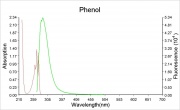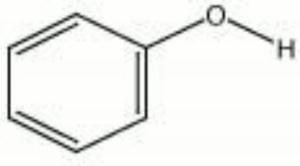Difference between revisions of "Phenol"
Jump to navigation
Jump to search
(username removed) |
|||
| (3 intermediate revisions by 2 users not shown) | |||
| Line 2: | Line 2: | ||
== Description == | == Description == | ||
| − | Colorless or white acicular crystals with a characteristic odor. Phenol was discovered in coal-tar by Runge. It is used in the production of dyes and resins. Phenol is also used as an [ | + | Colorless or white acicular crystals with a characteristic odor. Phenol was discovered in coal-tar by Runge. It is used in the production of dyes and resins. Phenol is also used as an [[disinfectant|disinfectant]] and [[fungicide|fungicide]]; it has been added to paints and glues as a preservative and odorant. |
== Synonyms and Related Terms == | == Synonyms and Related Terms == | ||
carbolic acid; phenylic acid; phenic acid; benzophenol; hydroxybenzene; oxybenzene; monohydroxybenzene | carbolic acid; phenylic acid; phenic acid; benzophenol; hydroxybenzene; oxybenzene; monohydroxybenzene | ||
| − | |||
[[[SliderGallery rightalign|phenol.jpg~Chemical structure]]] | [[[SliderGallery rightalign|phenol.jpg~Chemical structure]]] | ||
| + | == Risks == | ||
| − | == | + | * Highly toxic by ingestion, inhalation and skin absorption. LD50 = 530 mg/kg |
| + | * It is readily absorbed through the skin and causes severe burns. | ||
| + | * Combustible. Flash point = 79 (174 F) | ||
| + | * Fisher Scientific: [https://beta-static.fishersci.com/content/dam/fishersci/en_US/documents/programs/education/regulatory-documents/sds/chemicals/chemicals-p/S25463.pdf SDS] | ||
| + | == Physical and Chemical Properties == | ||
Soluble in water, ethanol, chloroform, ether, glycerol, carbon disulfide, oils, dilute alkalis. | Soluble in water, ethanol, chloroform, ether, glycerol, carbon disulfide, oils, dilute alkalis. | ||
| Line 23: | Line 27: | ||
|- | |- | ||
! scope="row"| Melting Point | ! scope="row"| Melting Point | ||
| − | | 43 | + | | 43 C |
|- | |- | ||
! scope="row"| Density | ! scope="row"| Density | ||
| − | | 1.071 | + | | 1.071 g/ml |
|- | |- | ||
! scope="row"| Molecular Weight | ! scope="row"| Molecular Weight | ||
| Line 35: | Line 39: | ||
|- | |- | ||
! scope="row"| Boiling Point | ! scope="row"| Boiling Point | ||
| − | | 182 | + | | 182 C |
|} | |} | ||
| − | == | + | == Resources and Citations == |
| − | |||
| − | |||
| − | |||
| − | |||
| − | |||
| − | |||
| − | |||
| − | |||
| − | |||
| − | |||
* Ralph Mayer, ''A Dictionary of Art Terms and Techniques'', Harper and Row Publishers, New York, 1969 (also 1945 printing) | * Ralph Mayer, ''A Dictionary of Art Terms and Techniques'', Harper and Row Publishers, New York, 1969 (also 1945 printing) | ||
Latest revision as of 07:15, 22 October 2022
Description
Colorless or white acicular crystals with a characteristic odor. Phenol was discovered in coal-tar by Runge. It is used in the production of dyes and resins. Phenol is also used as an Disinfectant and Fungicide; it has been added to paints and glues as a preservative and odorant.
Synonyms and Related Terms
carbolic acid; phenylic acid; phenic acid; benzophenol; hydroxybenzene; oxybenzene; monohydroxybenzene
Risks
- Highly toxic by ingestion, inhalation and skin absorption. LD50 = 530 mg/kg
- It is readily absorbed through the skin and causes severe burns.
- Combustible. Flash point = 79 (174 F)
- Fisher Scientific: SDS
Physical and Chemical Properties
Soluble in water, ethanol, chloroform, ether, glycerol, carbon disulfide, oils, dilute alkalis.
| Composition | C6H5OH |
|---|---|
| CAS | 108-95-2 |
| Melting Point | 43 C |
| Density | 1.071 g/ml |
| Molecular Weight | mol. wt.=94.11 |
| Refractive Index | 1.5425 |
| Boiling Point | 182 C |
Resources and Citations
- Ralph Mayer, A Dictionary of Art Terms and Techniques, Harper and Row Publishers, New York, 1969 (also 1945 printing)
- Susan E. Schur, Conservation Terminology: A review of Past & Current Nomenclature of Materials, Technology and Conservation, Spring (p.34-39); Summer (p.35-38); Fall (p.25-36), 1985
- Michael McCann, Artist Beware, Watson-Guptill Publications, New York City, 1979

